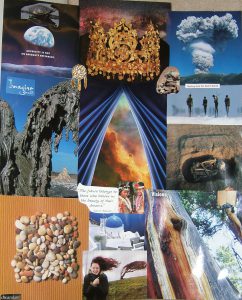Some days, tapping into creative expression feels like dowsing for water in a desert. I listen for that still, small voice, or the movie projector in my mind, to offer the next words, the next images, the next mood that my writing requires. And some days, no matter how hard I listen, the only thing my still, small voice whispers is that really, what it wants to do most is take a nap.
On those days, it’s time to fill the well.
I’ve heard from three friends in as many days who said that after years as successful writers, the stories just aren’t calling them. The passion is gone. They’re smart enough to recognize that they need to do something else for a while. One is trying her hand at drawing. Another at writing non-fiction.
When I get stuck, or am awaiting a new story to write, I often make a collage. I first did this as a creative exercise at a writing retreat offered maybe fifteen years ago by the Rocky Mountain Chapter of the Society of Children’s Book Writers and Illustrators. Barbara Steiner was the workshop facilitator, and we were encouraged to find images that intrigued us, or that we were drawn to. The subconscious aspect to it appealed to me, and the little girl in me was eager to play with scissors and glue. The room filled with a murmur of conversation as we flipped through old magazines looking for just the right images. What emerged, for me, was something almost magical. The images I chose then still hold meaning for me, and the collage still has a place on my office wall.
 Since then, I’ve made collages for novels I’m working on as well as ones that reflect my life. I find it easiest to make a collage if I have a few friends to chat with while I work, because the conversation occupies my monkey mind and gets it out of the way of the instinctive creative process. I almost always find patterns in the finished collage that surprise me, that I didn’t see when I put it together. And if I’ve made a collage for a novel, I find that the images can help prompt new scenes and ideas as I’m writing the story.
Since then, I’ve made collages for novels I’m working on as well as ones that reflect my life. I find it easiest to make a collage if I have a few friends to chat with while I work, because the conversation occupies my monkey mind and gets it out of the way of the instinctive creative process. I almost always find patterns in the finished collage that surprise me, that I didn’t see when I put it together. And if I’ve made a collage for a novel, I find that the images can help prompt new scenes and ideas as I’m writing the story.
I also turn to my easel, where creating art is not as infused with craft as it is in my writing. While I’ve studied with artists to learn the basics of color and shading, and while I’ve taken drawing classes and learned about seeing something in three dimensions and translating it into two, I don’t paint for anyone but myself, so concerns about technique and craft don’t impede me when I’m putting paint on a canvas.
Or I pull out my word pool and do a few free write sessions, where the only goal is to write for ten minutes and use all the words I pulled from the word pool. Sometimes I put other constraints on the exercise, like ending each line of a poem with one of the words, but usually I just write a scene.
The common element between collages and painting and free writing is the fact that all of these things are private expressions of art, never intended for public consumption and so free from the need to shape them so that other people can understand them. I think this sort of free play is essential for any artist, in any medium. Artists can get wrapped up in the attempt to express something inexpressible, to move an audience in a certain emotional direction, or have their art somehow change society. When creative expression is private, there’s a joy in the freedom to do exactly as I please, and in letting self-expression take precedence over the communication of an emotion or message or story.
Sometimes, the muse gets bored with always offering words, and wants to be fed color and images and movement. When I’m feeling depleted, I try to give my muse those things. I put on music that makes me dance, or haul out the old magazines and scissors. If only housework filled me up in the same way!
2 thoughts on “Filling the Well”
When I was in high school and college I used to doodle portraits of my characters in the margins of my class notes constantly. I haven’t done that in years. I wonder why not.
Maybe because you’re not sitting in boring lectures anymore?